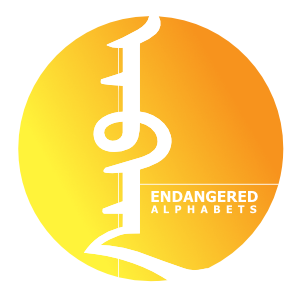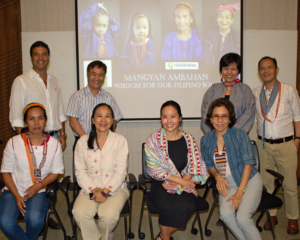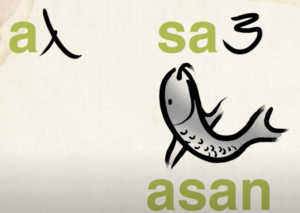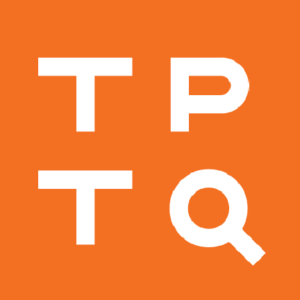World Endangered Writing Day 2025 Awards
There is very little recognition, let alone praise, for people who are working to revive their traditional or emerging scripts.
An endangered or emerging alphabet is almost always a symptom of a marginalized or suppressed community—a group of people who are routinely dismissed or discriminated against by their neighbors and, often, by the regional or national government.
If such a group, or an individual, tries to promote their script, at best they will be ignored; at worst, much worse things may happen. We know of at least four people who have been assassinated for trying to create or revive a script for their people, and others have been arrested or exiled.
Endangered Alphabets has therefore set up an awards ceremony for people and organizations engaged in such activities who deserve recognition. We don’t have any funds we can give them; we can only give them an award—but that award shows them that they are not working in isolation and darkness. It offers encouragement such as they may not otherwise get—and it also shows whoever is opposing them that out in the broad world, others are watching and applauding.
Field Research into Emerging Scripts of South Asia
Biswajit Mandal
For the past 75 years, the epicenter of new script creation has been South Asia, especially India. Nobody has done more to track and acquire information on such scripts, many of whom are known to only a handful of people, than Biswajit Mandal, whose day job is teaching elementary school in the Andaman Islands.
Field Research into Minority Scripts of Africa
Oreen Yousuf
Africa has a rich proliferation of scripts, many of which were created in defiance of colonial or governmental opposition and often kept secret. In 2023 Oreen Yousuf undertook the most detailed investigation of African scripts in 20 years, discovering some that were thought extinct and others that were not yet known to exist.
Community Script Preservation
The citizens of the villages of Kpotolu, Nyandeyama and Vaama in Sierra Leone, for keeping the Mende Kikakui script (created by Mohamed Turay and Kisimi Kamara in the early 20th century) alive for more than 50 years until the scholar Konrad Tuchscherer began working with them to revive it.
Minority Script Bookshop
The remarkable Inuit publishing group Inhabit Media has opened a bookshop in Toronto that Inhabit Books exclusively sells books from Nunavut and celebrates Inuit authors and Inuktitut language resources. It also carries children’s toys, gift cards, and CDs featuring music from Nunavut artists.
Special award for reviving an endangered or even extinct language
The main focus of the Endangered Alphabets Project is of course minority scripts rather than spoken minority languages, but we can’t resist the opportunity to draw attention to a feat that has often been considered impossible: relearning a language that has not been spoken for nearly a century. For researching, reconstructing, learning and now teaching the Takelma language of the Cow Creek band of the Umpqua tribe, beginning when she was barely out of high school, Elizabeth Bryant.
Documentary about a Minority Script
“Mangyan Ambahan: Wisdom for Our Filipino Soul,” a powerful documentary by Chiara Cox created in collaboration with the Mangyan Heritage Center. This film is a deep dive into one of the few surviving ancient Filipino writing systems—the Hanunuo Mangyan script. As one of only four pre-10th-century scripts still in use, it remains an essential part of Mangyan culture through the ambahan—beautiful, sung haiku-like poetry that shares wisdom across generations. Chiara’s documentary brings this unique tradition to life through interviews and stories, revealing its enduring impact on Filipino heritage and the global diaspora.
Historic Script Retrieval

Zafry Hadi and Ki Basajan
Working without funding and in their own spare time, this small team is researching ancestral scripts of southeast Asia–some of the most beautiful the world has ever seen–by deciphering monuments, many of them a thousand years old, and creating fonts so they can return to life. This work not only throws light on a rarely-explored area of script development, it offers a fascinating new aesthetics of writing. Their work can be seen HERE.
Theses Examining Minority Scripts from a Minority Viewpoint
Biyanto Rebin (“Paving Future Pathway for Disconnected Voices to Unbalanced Digital World: an analysis of multi-stakeholder perspective on improving the digital support for digitally-disadvantaged languages,” Uppsala University) and Allan Torres Camba (“Baybayin: The Role of a Written Language in the Cultural Identity and Socio-Psychological Well-Being of Filipinos,” Harvard University).
Minority Script Teaching Video
One of the brightest signs for script revival over the past decade has been the number, range and quality of teaching videos created and posted online. The winner for 2025 is for the Kulitan script of the Kapampangan language of the Philippines, made by the Aguman Sinupan Singsing organization.
As always, we acknowledge that our range of vision is severely limited, and we highly recommend and encourage you to submit your own nominations for next year’s awards!
This post is sponsored by our friends at Typotheque.










